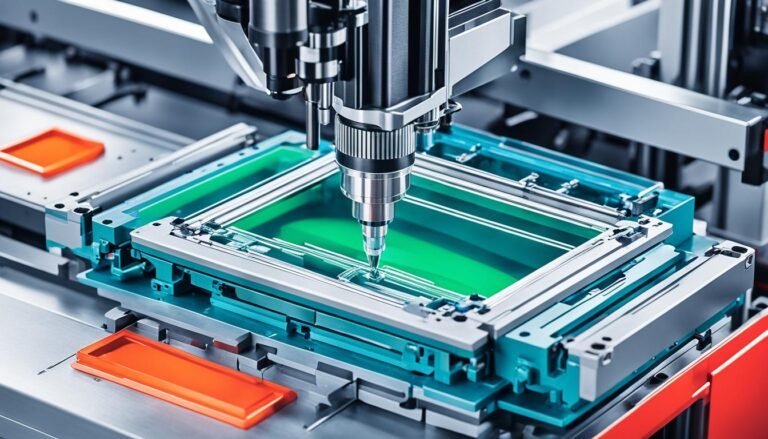Mastering the Injection Moulding Process Step by Step: A Beginner’s Guide
Are you ready to learn the secrets of Injection Moulding Process Step by Step? This THY Precision Injection Moulding Process Step by Step guide is perfect for manufacturers or newcomers to the field. It covers the entire process, from the basics to choosing materials and controlling quality. You’ll become an expert in injection moulding by the end.
Injection Moulding Process Step by Step is a top way to make lots of plastic parts quickly. It works by pouring molten plastic into a mold, where it cools and turns into the final product. We’ll show you how to make this process work well in your place, covering important steps and tips.
Key Takeaways
- Understand the fundamental principles of the Injection Moulding Process Step by Step and how it works.
- Learn the essential design considerations for injection mould design, including wall thickness and draft.
- Discover the criteria for selecting the right materials for your injection moulding applications.
- Explore the Injection Moulding Process Step by Step cycle and how to optimize each stage.
- Implement effective defect prevention and quality control measures to ensure consistent, high-quality parts.
Understanding the Injection Moulding Process Step by Step
The injection moulding process step by step is complex and fascinating. It turns raw plastic into many products. At its core, it uses heat, pressure, and precision for making identical plastic parts.
How Does Plastic Injection Moulding Process Step by Step Work?
The plastic injection moulding process starts with melting raw plastic pellets in a heated barrel. Then, the melted plastic is pushed into a mold under high pressure. As it cools, it takes the mold’s shape.
Finally, the mold opens, and the plastic part is ready for use. This process can be done many times, making lots of identical parts. The injection moulding process step by step shows how engineering and innovation work together.
“The injection moulding process step by step is a dance of heat, pressure, and precision that transforms raw materials into the products that shape our world.”
Design Principles for Injection Moulding Process Step by Step
At THY Precision, we know the injection moulding process step by step is complex. It needs careful design. A well-designed mould is key to making consistent, high-quality parts. Important design tips include uniform wall thickness, draft angles, and core geometry to avoid defects.
Wall Thickness and Draft
Proper wall thickness and draft are crucial in injection mould design. A consistent wall thickness helps prevent warping and other defects. Draft angles, between 0.5 and 3 degrees, make it easy to remove the part from the mould without damage.
The core geometry also matters. It helps with even flow and cooling of the material. Undercuts, bosses, gates, and ribs need careful planning to ensure the part comes out right and stays strong.
- Maintain uniform wall thickness to prevent warping and sink marks
- Incorporate appropriate draft angles, typically 0.5 to 3 degrees, for easy part ejection
- Optimize core geometry to promote even flow and cooling of the molten material
- Carefully design undercuts, bosses, gates, and ribs to ensure part structural integrity and easy ejection

By using these injection moulding design principles, THY Precision makes high-quality, consistent parts. Our team pays close attention to details. This ensures our clients get the best results from their injection moulding projects.
Material Selection for Injection Moulding
Choosing the right material is key in the injection moulding process step by step. There are many plastic injection moulding materials to pick from. These include common engineering resins like ABS, acetal, nylon, and polycarbonate. Also, there are commodity resins such as polypropylene, polyethylene, and polystyrene.
When picking plastic injection moulding materials, manufacturers must think about cost, strength, flexibility, and looks. Adding colorants and resin additives can make the final product better in both looks and performance.
It’s important to know about common engineering resins and commodity resins. This knowledge helps designers and engineers make smart choices. These choices lead to innovation and meet market demands.
| Material | Characteristics | Applications |
|---|---|---|
| ABS (Acrylonitrile Butadiene Styrene) | Durable, impact-resistant, and thermoplastic | Automotive parts, electronics, toys, and household appliances |
| Acetal (Polyoxymethylene) | Strong, rigid, and dimensionally stable | Gears, bearings, and mechanical parts |
| Nylon (Polyamide) | Tough, abrasion-resistant, and versatile | Automotive components, sporting goods, and industrial parts |
| Polycarbonate | Transparent, impact-resistant, and heat-resistant | Electronics, optical lenses, and safety equipment |
Choosing the right plastic injection moulding materials and colorants and resin additives is crucial. It helps manufacturers get the most out of the injection moulding process step by step. This leads to high-quality products that meet many needs in the market.
“The right material selection is the foundation for successful injection moulding. It’s not just about the cost, but the overall performance and aesthetics of the final product.”
injection moulding process step by step
At THY Precision, we know the injection moulding process is key to making top-quality products. This process has a clear cycle that guarantees reliable results. Let’s dive into the main steps of the injection moulding process.
The Injection Cycle
The cycle starts with the mould closing, trapping molten plastic inside. Then, the injection moulding process step by step injects plastic at high pressure into the mould. As it cools and solidifies, the mould opens, and the part comes out. This whole process, from start to finish, takes less than a minute, making it fast and efficient.
It’s crucial to manage the moulding cycle time and mould cavity filling well. This ensures the plastic flows right and fills the mould fully. The temperature, pressure, and cooling time must be set just right for this.
| Stage | Description |
|---|---|
| Mould Closing | The two halves of the mould close, trapping the molten plastic inside. |
| Injection | The molten plastic is injected at high pressure into the mould cavity. |
| Cooling | The plastic cools and solidifies within the mould. |
| Mould Opening | The mould opens, and the finished part is ejected. |
By mastering and controlling each step of the injection moulding process step by step, THY Precision makes sure we produce parts that are top-notch and consistent. Our customers love them.

Defect Prevention and Quality Control
At THY Precision, we know keeping quality high and preventing defects is key in the injection moulding process step by step. We use strict quality control steps to make sure our products are top-notch.
We check dimensions, look for visual issues, and test samples at each step of the injection moulding process step by step. This helps us fix problems like sink marks, warping, and flash early. This way, our products always meet the highest standards.
We also work on making the injection moulding process step by step better by choosing the right design and materials. Our experts look at mould design, material types, and process settings. They find and fix problems to stop defects before they start.
With strong quality control measures and defect prevention plans, THY Precision aims to give our clients the best results. We’re proud to make high-quality parts that go beyond what our customers hope for.
Our drive for success comes from always getting better. We check our methods, look at data, and use the best practices. This makes our injection moulding process step by step better and keeps quality high. Quality is a big part of our company’s values. It means every product we make is precise and reliable.
Conclusion
Learning the injection moulding process step by step is key for making lots of plastic parts with precision and efficiency. THY Precision’s guide has given a detailed look at the main principles, design tips, material choices, and quality checks needed for plastic injection moulding. By knowing and using these best practices, companies can make the most of this flexible moulding machine operations. This leads to making high-quality, affordable products for customers.
This guide has shown how important it is to understand the injection moulding process step by step, from the start to the end. By getting better at these methods, manufacturers can make their production smoother, cut down on mistakes, and get consistent, reliable results. This guide has given you the key knowledge and strategies to do well, whether you’re new or experienced in plastic injection moulding.
As you move forward in injection moulding process step by step, always be alert, ready to change, and focused on getting better. The world of moulding machine operations is always changing, and those who stay ahead will do well in a tough market. With the insights and best practices from this guide, THY Precision believes you have what you need to excel in the injection moulding process step by step. You’re ready to take your manufacturing to new heights.







